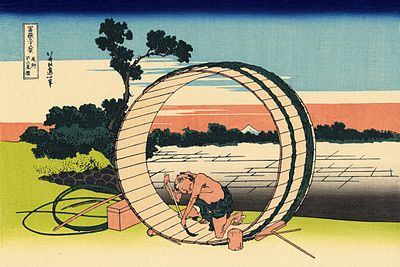
Katsushika Hokusai, Fuji Viewed from Rice Fields in Owari Province, part of the series Thirty-six Views of Mount Fuji, no. 40, 4th additional woodcut, first publication: circa 1830, this edition: circa 1930. Woodblock color print.
Ultimately, a work of art is the strongest when it expresses an overall unity in composition and form, a visual sense that all the parts fit together, that the whole is greater than its parts. This same sense of unity is projected to encompass the idea and meaning of the work too. This visual and conceptual unity is sublimated by the variety of elements and principles used to create it. We can think of this in terms of a musical orchestra and its conductor: directing many different instruments, sounds and feelings into a single comprehendible symphony of sound. This is where the objective functions of line, color, pattern, scale and all the other artistic elements and principles yield to a more subjective view of the entire work, and from that an appreciation of the aesthetics and meaning it resonates.
We can view the woodblock print, “Fuji Viewed from Rice Fields in Owari Province” part of the series, Thirty-Six Views of Mount Fuji designed by Katsushika Hokusai to see how unity and variety work together. Hokusai made use of nearly every element and principle in his work, including a range of values, colors, and textures in his depiction of a barrel maker set against a parched rice-field with Mount Fuji in the distance. The unity of the print is held in place by the large barrel which encloses and unifies the individual elements of the composition.
Complete an internet search for the Thirty-Six Views of Mount Fuji designed by Katsushika Hokusai. How did the artist achieve unity and variety in this series?
You must be logged in to post to WEnotes.
Note: Your comment will be displayed in the course feed.
In this learning pathway, you have looked at several artistic principles that artists follow as they create their works or art: it is as if they have a language of their own. You saw how realistic artwork can be transformed into abstract compositions, and explored the effectiveness of various compositional considerations. As you progress with the next two micro-courses (ART 102 and ART 103) in the ART 100 series, you will continue to appreciate the impact that culture has in the world of art creation.
Overview
Ultimately, a work of art is the strongest when it expresses an overall unity in composition and form, a visual sense that all the parts fit together, that the whole is greater than its parts. This same sense of unity is projected to encompass the idea and meaning of the work too. This visual and conceptual unity is sublimated by the variety of elements and principles used to create it. We can think of this in terms of a musical orchestra and its conductor: directing many different instruments, sounds and feelings into a single comprehendible symphony of sound. This is where the objective functions of line, color, pattern, scale and all the other artistic elements and principles yield to a more subjective view of the entire work, and from that an appreciation of the aesthetics and meaning it resonates.
We can view the woodblock print, “Fuji Viewed from Rice Fields in Owari Province” part of the series, Thirty-Six Views of Mount Fuji designed by Katsushika Hokusai to see how unity and variety work together. Hokusai made use of nearly every element and principle in his work, including a range of values, colors, and textures in his depiction of a barrel maker set against a parched rice-field with Mount Fuji in the distance. The unity of the print is held in place by the large barrel which encloses and unifies the individual elements of the composition.
Complete an internet search for the Thirty-Six Views of Mount Fuji designed by Katsushika Hokusai. How did the artist achieve unity and variety in this series?
You must be logged in to post to WEnotes.
Note: Your comment will be displayed in the course feed.
Summary
In this learning pathway, you have looked at several artistic principles that artists follow as they create their works or art: it is as if they have a language of their own. You saw how realistic artwork can be transformed into abstract compositions, and explored the effectiveness of various compositional considerations. As you progress with the next two micro-courses (ART 102 and ART 103) in the ART 100 series, you will continue to appreciate the impact that culture has in the world of art creation.
Content is available under the
Creative Commons Attribution Share Alike License.
Privacy Policy | Authors